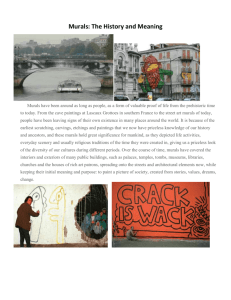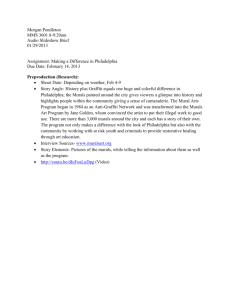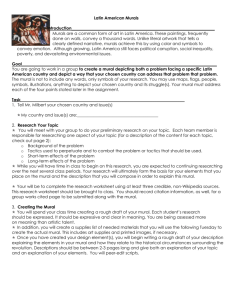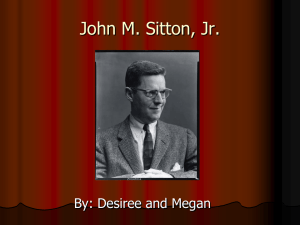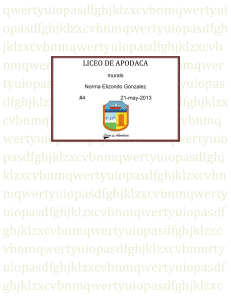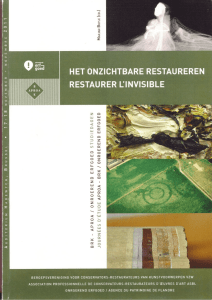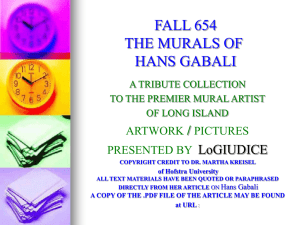How to create a mural
advertisement
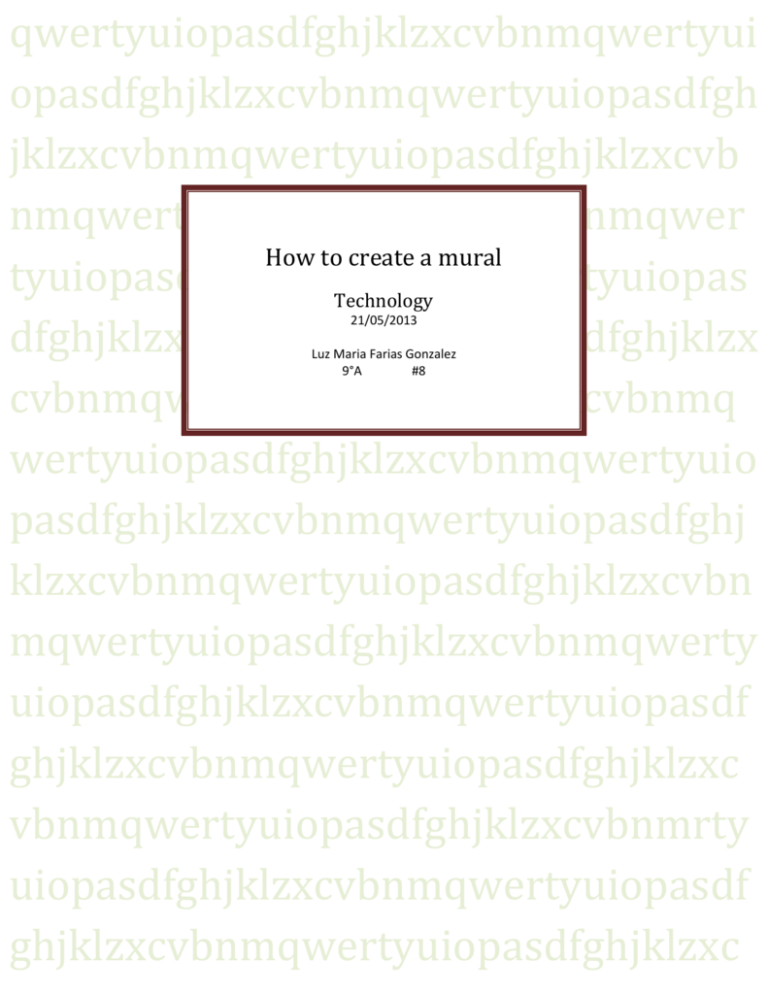
qwertyuiopasdfghjklzxcvbnmqwertyui opasdfghjklzxcvbnmqwertyuiopasdfgh jklzxcvbnmqwertyuiopasdfghjklzxcvb nmqwertyuiopasdfghjklzxcvbnmqwer How to create a mural tyuiopasdfghjklzxcvbnmqwertyuiopas Technology dfghjklzxcvbnmqwertyuiopasdfghjklzx cvbnmqwertyuiopasdfghjklzxcvbnmq wertyuiopasdfghjklzxcvbnmqwertyuio pasdfghjklzxcvbnmqwertyuiopasdfghj klzxcvbnmqwertyuiopasdfghjklzxcvbn mqwertyuiopasdfghjklzxcvbnmqwerty uiopasdfghjklzxcvbnmqwertyuiopasdf ghjklzxcvbnmqwertyuiopasdfghjklzxc vbnmqwertyuiopasdfghjklzxcvbnmrty uiopasdfghjklzxcvbnmqwertyuiopasdf ghjklzxcvbnmqwertyuiopasdfghjklzxc 21/05/2013 Luz Maria Farias Gonzalez 9°A #8 Index What is a mural? .................................................................. 3 History ……………………………………………………………. 4 Significance …………………………………………………….. 5 Functions ………………………………………………………... 7 Technique ………………………………………………………. 7 Famous muralists ……………………………………………... 11 Reference Sources: ………………………………………….. 14 Pictures ………………………………………………………… 15 2 What is a mural? A mural is any piece of artwork painted or applied directly on a wall, ceiling or other large permanent surface. A particularly distinguishing characteristic of mural painting is that the architectural elements of the given space are harmoniously incorporated into the picture. Some wall paintings are painted on large canvases, which are then attached to the wall (e.g., with marouflage). Whether these works can be accurately called "murals" is a subject of some controversy in the art world, but the technique has been in common use since the late 19th century. 3 History: Murals of sorts date to Upper Paleolithic times such as the paintings in the Chauvet Cave in Ardèche department of southern France (around 30,000 BC). Many ancient murals have survived in Egyptian tombs (around 3150 BC),[2] the Minoan palaces (Middle period III of the Neopalatial period, 1700-1600 BC) and in Pompeii (around 100 BC - AD 79). In modern times, the term became more well-known with the Mexican "muralista" art movement (Diego Rivera, David Siqueiros, or José Orozco). There are many different styles and techniques. The best-known is probably fresco, which uses water-soluble paints with a damp lime wash, a rapid use of the resulting mixture over a large surface, and often in parts (but with a sense of the whole). The colors lighten as they dry. The marouflage method has also been used for millennia. Murals today are painted in a variety of ways, using oil or water-based media. The styles can vary from abstract to trompe-l'œil (a French term for "fool" or "trick the eye"). Initiated by the works of mural artists like Graham Rust or Rainer Maria Latzke in the 1980s, trompel'oeil painting has experienced a renaissance in private and public buildings in Europe. Today, the beauty of a wall mural has become much more widely available with a technique whereby a painting or photographic image is transferred to poster paper or canvas which is then pasted to a wall surface (seewallpaper, Frescography) to give the effect of either a hand-painted mural or realistic scene. 4 Significance: Murals are important in that they bring art into the public sphere. Due to the size, cost, and work involved in creating a mural, muralists must often be commissioned by a sponsor. Often it is the local government or a business, but many murals have been paid for with grants of patronage. For artists, their work gets a wide audience who otherwise might not set foot in an art gallery. A city benefits by the beauty of a work of art. Murals can be a relatively effective tool of social emancipation or achieving a political goal. Murals have sometimes been created against the law, or have been commissioned by local bars and coffeeshops. Often, the visual effects are an enticement to attract public attention to social issues. State-sponsored public art expressions, particularly murals, are often used by totalitarian regimes as a tool of mass-control and propaganda. However, despite the propagandist character of that works, some of them still have an artistic value. Murals can have a dramatic impact whether consciously or subconsciously on the attitudes of passers by, when they are added to areas where people live and work. It can also be argued that the presence of large, public murals can add aesthetic improvement to the daily lives of residents or that of employees at a corporate venue. Other world-famous murals can be found in Mexico, New York, Philadelphia, Belfast, Derry, Los Angeles, Nicaragua, Cuba and in India. They have functioned as an important means of communication for 5 members of socially, ethnically and racially divided communities in times of conflict. They also proved to be an effective tool in establishing a dialogue and hence solving the cleavage in the long run. The Indian state Kerala has exclusive murals. These Kerala mural painting are on walls of Hindu temples. They can be dated from 9th century AD. The San Bartolo murals of the Maya civilization in Guatemala, are the oldest example of this art in Mesoamerica and are dated at 300 BC. Many rural towns have begun using murals to create tourist attractions in order to boost economic income. Colquitt, Georgia is one such town. Colquitt was chosen to host the 2010 Global Mural Conference. The town has more than twelve murals completed, and will host the Conference along with Dothan, Alabama, and Blakely, Georgia. In the summer of 2010, Colquitt will begin work on their Icon Mural. 6 Functions: The function of murals varies from culture to culture and from one time period to another. In the Tibetan world many murals, both ancient and contemporary, are created as part of reflective and meditative Buddhist practices. These mandalas are a part of the spirituality of Tibetan monks and their devotees. During the Baroque period in England, Germany, and France, royalty and rich art patrons had allegorical and Biblical murals painted on the walls and ceilings of their palaces or luxurious homes. Into these they inserted themselves or loved ones as a way of capturing their likenesses for posterity. Technique: In the history of mural several methods have been used: A fresco painting, from the Italian word affresco which derives from the adjective fresco ("fresh"), describes a method in which the paint is applied on plaster on walls or ceilings. The buon fresco technique consists of painting in pigment mixed with water on a thin layer of wet, fresh, lime mortar or plaster. The pigment is then absorbed by the wet plaster; after a number of hours, the plaster dries and reacts with the air: it is this chemical reaction which fixes the pigment particles in the plaster. After this the painting stays for a long time up to centuries in fresh and brilliant colors. Fresco-secco painting is done on dry plaster (secco is "dry" in Italian). The pigments thus require a binding 7 medium, such as egg (tempera), glue or oil to attach the pigment to the wall. Mezzo-fresco is painted on nearly-dry plaster was defined by the sixteenth-century author Ignazio Pozzo as "firm enough not to take a thumb-print" so that the pigment only penetrates slightly into the plaster. By the end of the sixteenth century this had largely displaced the buon fresco method, and was used by painters such as Gianbattista Tiepolo or Michelangelo. This technique had, in reduced form, the advantages of a secco work. Material: In Greco-Roman times, mostly encaustic colors ground in a molten beeswax or resin binder and applied in a hot state was used. Tempera painting is one of the oldest known methods in mural painting. In tempera, the pigments are bound in an albuminous medium such as egg yolk or egg white diluted in water. In 16th-century Europe, oil painting on canvas arose as an easier method for mural painting. The advantage was that the artwork could be completed in the artist’s studio and later transported to its destination and there attached to the wall or ceiling. Oil paint can be said to be the least satisfactory medium for murals because of its lack of brilliance in colour. Also the pigments are yellowed by the binder or are more easily affected by atmospheric conditions. The canvas itself is more subject to rapid deterioration than a plaster ground. 8 Modern mural techniques: Different muralists tend to become experts in their preferred medium and application, whether that be oil paints, emulsion or acrylic paints applied by brush, roller or airbrush/aerosols. Clients will often ask for a particular style and the artist may adjust to the appropriate technique. A consultation usually leads to a detailed design and layout of the proposed mural with a price quote that the client approves before the muralist starts on the work. The area to be painted can be gridded to match the design allowing the image to be scaled accurately step by step. In some cases the design is projected straight onto the wall and traced with pencil before painting begins. Some muralists will paint directly without any prior sketching, preferring the spontaneous technique. Once completed the mural can be given coats of varnish or protective acrylic glaze to protect the work from UV rays and surface damage. As an alternative to a hand-painted or airbrushed mural, digitally printed murals can also be applied to surfaces. Already existing murals can be photographed and then be reproduced in near-to-original quality. The disadvantages of pre-fabricated murals and decals are that they are often mass-produced and lack the allure and exclusivity of an original artwork. They are often not fitted to the individual wall sizes of the client and their personal ideas or wishes can not be added to the mural as it progresses. The Frescography technique, a digital manufacturing method (CAM) invented by 9 Rainer Maria Latzke addresses some of the personalisation and size restrictions. Digital techniques are commonly used in advertisements. A "wallscape" is a large advertisement on or attached to the outside wall of a building. Wallscapes can be painted directly on the wall as a mural, or printed on vinyl and securely attached to the wall in the manner of a billboard. Although not strictly classed as murals, large scale printed media are often referred to as such. Advertising murals were traditionally painted onto buildings and shops by sign-writers, later as large scale poster billboards. 10 Famous muralists: Leonardo da Vinci: Despite the recent awareness and admiration of Leonardo as a scientist and inventor, for the better part of four hundred years his fame rested on his achievements as a painter and on a handful of works, either authenticated or attributed to him that have been regarded as among the masterpieces. These paintings are famous for a variety of qualities which have been much imitated by students and discussed at great length by connoisseurs and critics. Among the qualities that make Leonardo's work unique are the innovative techniques that he used in laying on the paint, his detailed knowledge of anatomy, light, botany and geology, his interest in physiognomy and the way in which humans register emotion in expression and gesture, his innovative use of the human form in figurative composition, and his use of the subtle gradation of tone. All these qualities come together in his most famous painted works, the Mona Lisa, the Last Supper and the Virgin of the Rocks. Michelangelo: Michelangelo was considered the greatest living artist in his lifetime, and ever since then he has been held to be one of the greatest artists of all time. A number of his works in painting, sculpture, and architecture rank among the most famous in existence. His output in every field during his long life was prodigious; when the sheer volume of correspondence, sketches, and reminiscences that survive is also taken into account, he is the best-documented artist of the 16th century. 11 Two of his best-known works, the Pietà and David, were sculpted before he turned thirty. Despite his low opinion of painting, Michelangelo also created two of the most influential works infresco in the history of Western art: the scenes from Genesis on the ceiling and The Last Judgment on the altar wall of the Sistine Chapel in Rome. As an architect, Michelangelo pioneered the Mannerist style at the Laurentian Library. At 74 he succeeded Antonio da Sangallo the Younger as the architect of St. Peter's Basilica. Michelangelo transformed the plan, the western end being finished to Michelangelo's design, the dome being completed after his death with some modification. Diego Rivera: Rivera studied art at the Academy of San Carlos in Mexico City. He was sponsored to continue study in Europe by Teodoro A. Dehesa Méndez, the governor of the State of Veracruz. His mother was a Converso, a Jew whose ancestors had been forced to convert to Catholicism. Speaking about himself, Rivera wrote in 1935: "My Jewishness is the dominant element in my life." After arrival in Europe in 1907, Rivera initially went to study with Eduardo Chicharro in Madrid, Spain, and from there went to Paris, France, to live and work with the great gathering of artists in Montparnasse, especially at La Ruche, where his friend Amedeo Modigliani painted his portrait in 1914. His circle of close friends, which included Ilya Ehrenburg, Chaim Soutine, Amedeo Modigliani and Modigliani's wife Jeanne Hébuterne, Max Jacob, gallery 12 owner Léopold Zborowski, and Moise Kisling, was captured for posterity by Marie Vorobieff-Stebelska (Marevna) in her painting "Homage to Friends from Montparnasse" (1962). His mural Man at the Crossroads, begun in 1933 for the Rockefeller Center in New York City, was removed after a furor erupted in the press over a portrait of Vladimir Lenin it contained. The American poet Archibald MacLeish wrote six "irony-laden" poems about the mural.[20] The New Yorker magazine published E. B. White's poem "I paint what I see: A ballad of artistic integrity".[21] As a result of the negative publicity, a further commission was canceled to paint a mural for an exhibition at the Chicago World's Fair. Rivera issued a statement that with the money left over from the commission of the mural at Rockefeller Center (he was paid in full though the mural was supposedly destroyed. Rumors have floated that the mural was actually covered over rather than brought down and destroyed.), he would repaint the same mural over and over wherever he was asked until the money ran out. In those years, Paris was witnessing the beginning of cubism in paintings by such eminent painters as Pablo Picasso and Georges Braque. From 1913 to 1917, Rivera enthusiastically embraced this new school of art. Around 1917, inspired by Paul Cézanne's paintings, Rivera shifted toward Post-Impressionism with simple forms and large patches of vivid colors. His paintings began to attract attention, and he was able to display them at several exhibitions. 13 Reference sources: http://en.wikipedia.org/wiki/Mural http://wiki.answers.com/Q/Who_are_some_famous_mur alists http://en.wikipedia.org/wiki/Diego_Rivera http://en.wikipedia.org/wiki/Leonardo_da_Vinci http://en.wikipedia.org/wiki/Michelangelo http://mx.answers.yahoo.com/question/index?qid=2009 0615135658AApzg8o Personal conclusión: I think the murals are a form of expression of the people and they paint their ideas in the walls. 14 Pictures: 15
